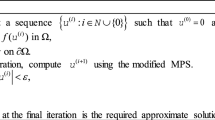Abstract
In this paper we study higher-order interior point algorithms, especially power-series algorithms, for solving linear programming problems. Since higher-order differentials are not parameter-invariant, it is important to choose a suitable parameter for a power-series algorithm. We propose a parameter transformation to obtain a good choice of parameter, called ak-parameter, for general truncated powerseries approximations. We give a method to find ak-parameter. This method is applied to two powerseries interior point algorithms, which are built on a primal—dual algorithm and a dual algorithm, respectively. Computational results indicate that these higher-order power-series algorithms accelerate convergence compared to first-order algorithms by reducing the number of iterations. Also they demonstrate the efficiency of thek-parameter transformation to amend an unsuitable parameter in power-series algorithms.
Similar content being viewed by others
References
D.A. Bayer and J.C. Lagarias, “The nonlinear geometry of linear programming I: Affine and projective scaling trajectories,”Transactions of the American Mathematical Society 314 (1989) 499–526.
D.A. Bayer and J.C. Lagarias, “The nonlinear geometry of linear programming II: Legendre transform coordinates,”Transactions of the American Mathematical Society 314 (1989) 527–581.
I.S. Gradshteyn and I.M. Ryzhik,Table of Integrals (corrected and enlarged edition) (Academic Press, New York, 1980).
D. den Hertog and C. Roos, “A survey of search directions in interior point methods for linear programming,” Reports of the Faculty of Technical Mathematics and Informatics, No 89-65, Delft University of Technology (1989).
M. Iri and H. Imai, “A multiplicative barrier function method for linear programming,”Algorithmica 1 (1986) 455–482.
Fl. Jarre, “The method of analytic centers for smooth convex programs,” Dissertation, University Würzburg (Grottenthaler Verlag, Bamberg, 1989).
N.K. Karmarkar, “A new polynomial time algorithm for linear programming,”Combinatorica 4 (1984) 373–395.
N.K. Karmarkar, J.C. Lagarias, L. Slutsman and P. Wang, “Power series variants of Karmarkar-type algorithms,”AT&T Technical Journal 68 (1989) 20–36.
M. Kojima, N. Megiddo, T. Noma and A. Yoshise, “A unified approach to interior point algorithms for linear complementarity problems,” research report RJ 7493, IBM Almaden Research Center, San Jose, CA (1990).
J.C. Lagarias, “The nonlinear geometry of linear programming III: Projective Legendre transform coordinates and Hilbert geometry,”Transactions of the American Mathematical Society 320 (1990) 193–225.
N. Megiddo, “On the complexity of linear programming,” in: T. Bewley, ed.Advances in Economic Theory (Cambridge University Press, Cambridge, 1987) 225–268.
S. Mehrotra, “Higher order methods and their performance,” Technical report 90-16R1, Dept. of industrial Engineering and Management Science, Northwestern University, Evanston, IL (1990; revised July 1991).
G. Sonnevend, “An analytical center for polyhedrons and new classes of global algorithms for linear (smooth, convex) programming,”Lecture Notes in Control and Information Sciences 84 (Springer-Verlag, Berlin-Heidelberg-New York, 1985) 866–876.
G. Sonnevend, J. Stoer and G. Zhao, “On the complexity of following the central path of linear programs by linear extrapolation II,”Mathematical Programming 52 (1991) 527–553.
M.J. Todd, “Recent developments and new directions in linear programming,” in: M. Iri and K. Tanabe, eds.,Mathematical Programming—Recent Developments and Applications (Kluwer Academic, Dordrecht—Boston—London, 1989) 109–157.
G. Zhao, “Estimating the complexity of path-following methods in linear programming by curvature integrals along the central trajectory,” Dissertation, University Würzburg, Germany (1991).
G. Zhao and J. Stoer, “Estimating the complexity of path-following methods for solving linear programs by curvature integrals,”Applied Mathematics and Optimization 27 (1993) 85–103.
Author information
Authors and Affiliations
Additional information
Work supported in part by the DFG Schwerpunktprogramm “Anwendungsbezogene Optimierung und Steuerung”.
Rights and permissions
About this article
Cite this article
Zhao, G. On the choice of parameters for power-series interior point algorithms in linear programming. Mathematical Programming 68, 49–71 (1995). https://doi.org/10.1007/BF01585757
Received:
Revised:
Issue Date:
DOI: https://doi.org/10.1007/BF01585757



